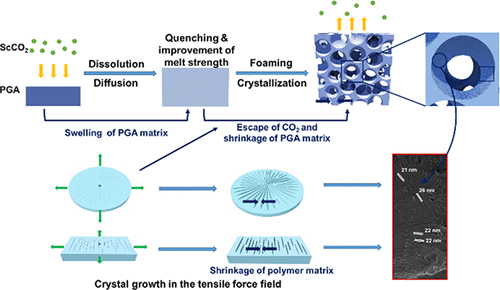当前位置:
X-MOL 学术
›
ACS Biomater. Sci. Eng.
›
论文详情
Our official English website, www.x-mol.net, welcomes your
feedback! (Note: you will need to create a separate account there.)
Novel Fabricating Process for Porous Polyglycolic Acid Scaffolds by Melt-Foaming Using Supercritical Carbon Dioxide
ACS Biomaterials Science & Engineering ( IF 5.4 ) Pub Date : 2018-01-27 00:00:00 , DOI: 10.1021/acsbiomaterials.7b00692 Jiapeng Zhang 1 , Shengbing Yang , Xi Yang , Zhenhao Xi 1, 2 , Ling Zhao 1, 2 , Lian Cen 1 , Eryi Lu 3 , Ying Yang 4
ACS Biomaterials Science & Engineering ( IF 5.4 ) Pub Date : 2018-01-27 00:00:00 , DOI: 10.1021/acsbiomaterials.7b00692 Jiapeng Zhang 1 , Shengbing Yang , Xi Yang , Zhenhao Xi 1, 2 , Ling Zhao 1, 2 , Lian Cen 1 , Eryi Lu 3 , Ying Yang 4
Affiliation

|
Polyglycolic acid (PGA) is a biocompatible and biodegradable polymer with high crystallinity. It is difficult to obtain PGA porous scaffolds with controllable morphology as well as outstanding mechanical properties without toxic solvents. The current study thus aimed to develop a novel melt-foaming strategy to prepare porous PGA scaffolds through the interaction between PGA molecules and supercritical carbon dioxide (scCO2). Before the design of foaming strategy, rheological properties of PGA were first studied by a Haake rheometer, whereas the effect of scCO2 on PGA was investigated by high-pressure differential scanning calorimetry (DSC). It was revealed that the elasticity and viscosity could be greatly improved by a temperature regulation operation to withstand the growth of bubbles at the initial depressurization. Meanwhile, the melting and crystallization temperatures of PGA were reduced because of the plasticization effect of scCO2. Through the dissolution of compressed CO2 into PGA melt and subsequent rapid depressurization at a relatively low temperature with high PGA melt strength, PGA scaffolds with porosity of 39–74%, average pore sizes ranging from 5 to 50 μm, and interconnectivity greater than 90% could be controllably fabricated. The effect of foaming temperature and pressure on morphology of PGA foams were then examined in detail. Special nanoscale morphology on the pore surface of resultant porous PGA foams was observed. These PGA foams also exhibited attractive compressive modulus of 68–116 MPa. The PGA foams with 74% porosity and average pore size of 38 μm, prepared at 208 °C and 20 MPa were then used as scaffolds for in vitro cellular evaluation. Fibroblasts seeded on the scaffold exhibited excellent spreading shape and good proliferation ability and in vivo implantation of PGA foams manifested as the notable tissue ingrowth and neovascularization process within the foams, ascertaining its potential applications for tissue engineering and regenerative medicine. This work presents a breakthrough to fabricate highly crystalline PGA into porous scaffolds instead of traditional fibrous ones.
中文翻译:

超临界二氧化碳熔融发泡制备多孔聚乙醇酸支架的新工艺
聚乙醇酸(PGA)是具有高结晶度的生物相容性和可生物降解的聚合物。在没有有毒溶剂的情况下,很难获得具有可控形态和出色机械性能的PGA多孔支架。因此,当前的研究旨在开发一种新颖的熔融发泡策略,以通过PGA分子与超临界二氧化碳(scCO 2)之间的相互作用来制备多孔PGA支架。在设计发泡策略之前,首先通过Haake流变仪研究了PGA的流变特性,而scCO 2的影响通过高压差示扫描量热法(DSC)研究了PGA的性能。揭示了通过进行温度调节操作以承受初始减压时气泡的生长可以极大地改善弹性和粘度。同时,由于scCO 2的增塑作用,降低了PGA的熔融和结晶温度。通过压缩的CO 2的溶解进入PGA熔体,随后在相对较低的温度下以较高的PGA熔体强度进行快速降压,可以控制地制造孔隙率为39–74%,平均孔径为5至50μm,互连度大于90%的PGA支架。然后详细研究了发泡温度和压力对PGA泡沫形态的影响。在所得的多孔PGA泡沫的孔表面上观察到特殊的纳米级形态。这些PGA泡沫还表现出有吸引力的68-116 MPa的压缩模量。然后在208°C和20 MPa下制备的具有74%孔隙率和38μm平均孔径的PGA泡沫材料用作体外细胞评估的支架。接种在支架上的成纤维细胞表现出优异的铺展形状和良好的增殖能力,PGA泡沫的体内植入表现为泡沫内显着的组织向内生长和新血管形成过程,从而确定了其在组织工程和再生医学中的潜在应用。这项工作为将高结晶度的PGA制成多孔支架而不是传统的纤维支架提供了突破。
更新日期:2018-01-27
中文翻译:

超临界二氧化碳熔融发泡制备多孔聚乙醇酸支架的新工艺
聚乙醇酸(PGA)是具有高结晶度的生物相容性和可生物降解的聚合物。在没有有毒溶剂的情况下,很难获得具有可控形态和出色机械性能的PGA多孔支架。因此,当前的研究旨在开发一种新颖的熔融发泡策略,以通过PGA分子与超临界二氧化碳(scCO 2)之间的相互作用来制备多孔PGA支架。在设计发泡策略之前,首先通过Haake流变仪研究了PGA的流变特性,而scCO 2的影响通过高压差示扫描量热法(DSC)研究了PGA的性能。揭示了通过进行温度调节操作以承受初始减压时气泡的生长可以极大地改善弹性和粘度。同时,由于scCO 2的增塑作用,降低了PGA的熔融和结晶温度。通过压缩的CO 2的溶解进入PGA熔体,随后在相对较低的温度下以较高的PGA熔体强度进行快速降压,可以控制地制造孔隙率为39–74%,平均孔径为5至50μm,互连度大于90%的PGA支架。然后详细研究了发泡温度和压力对PGA泡沫形态的影响。在所得的多孔PGA泡沫的孔表面上观察到特殊的纳米级形态。这些PGA泡沫还表现出有吸引力的68-116 MPa的压缩模量。然后在208°C和20 MPa下制备的具有74%孔隙率和38μm平均孔径的PGA泡沫材料用作体外细胞评估的支架。接种在支架上的成纤维细胞表现出优异的铺展形状和良好的增殖能力,PGA泡沫的体内植入表现为泡沫内显着的组织向内生长和新血管形成过程,从而确定了其在组织工程和再生医学中的潜在应用。这项工作为将高结晶度的PGA制成多孔支架而不是传统的纤维支架提供了突破。











































 京公网安备 11010802027423号
京公网安备 11010802027423号